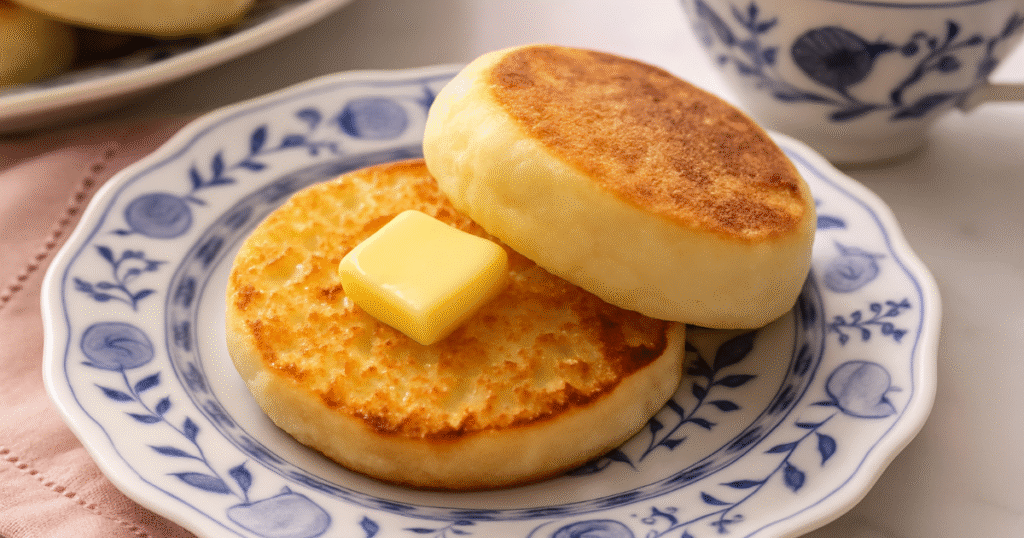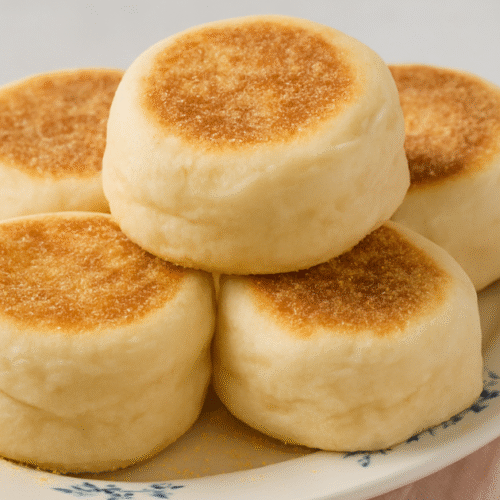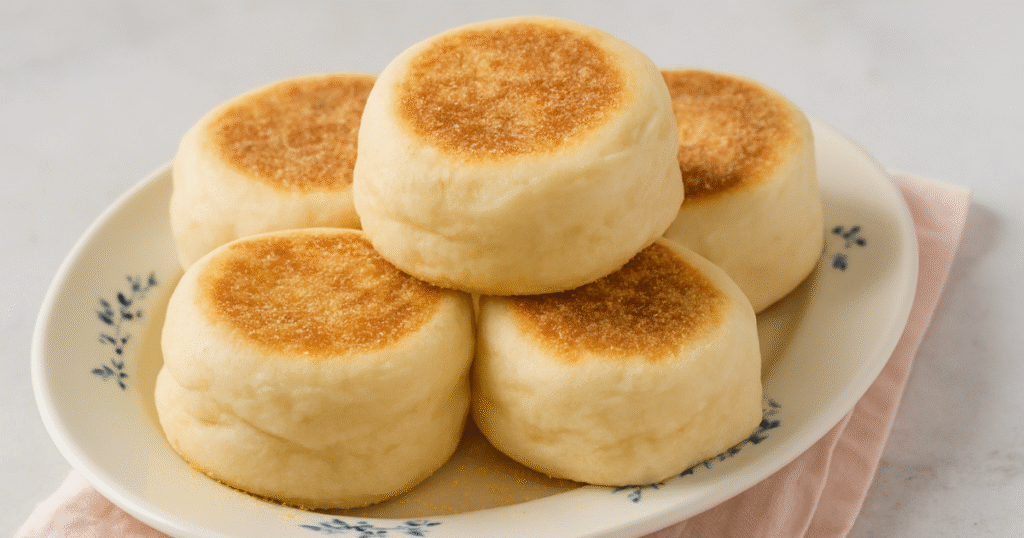I’ll be honest: I used to think making English muffins at home was way out of my league. All that talk about rising dough, shaping, and skillet-cooking? It felt intimidating. But let me tell you—once I actually tried it, I never went back to store-bought again. This English muffin recipe is shockingly simple, and the results are bakery-worthy.
Whether you’re dreaming of the perfect base for eggs Benedict or just want something crisp and golden for your morning butter-and-jam moment, this recipe’s got you covered. And yes, those iconic nooks and crannies are absolutely part of the deal.
Stick with me, and I’ll walk you through the ingredients, step-by-step instructions, common pitfalls, variations, and how to store and reheat your muffins like a pro.
Why You’ll Love This English Muffin Recipe
- ✅ Soft inside, crispy outside – You get that golden crust and light, airy middle.
- ✅ Perfect for breakfast sandwiches – Bacon, eggs, avocado—yes please.
- ✅ Made with pantry staples – Just flour, milk, yeast, and a few extras.
- ✅ Better than store-bought – Fresher taste and fewer preservatives.
- ✅ Freezer-friendly – Bake once, enjoy for weeks.
Whether you’re making them for weekend brunch or prepping ahead, these homemade English muffins add flavor and comfort to your morning routine.
Ingredients You’ll Need
Here’s everything you need to make a batch of fluffy, golden English muffins from scratch:
- 1 ¾ cups warm milk (about 110°F)
- 1 tablespoon granulated sugar
- 1 tablespoon active dry yeast
- 1 large egg, room temperature
- 3 tablespoons melted butter
- 4 ½ cups all-purpose flour
- 1 teaspoon salt
- ½ cup warm water (as needed, to adjust dough texture)
- Cornmeal (for dusting)
Tip: Make sure your milk and water are warm—not hot—or it can kill the yeast. Aim for baby-bath warm.
Ingredient Substitutions
- Active dry yeast → Swap with instant yeast; reduce proofing time slightly.
- Warm milk → Use warm water + 2 tablespoons powdered milk for a dairy-free version.
- All-purpose flour → Bread flour creates a slightly chewier texture if that’s your thing.
- Melted butter → Sub with avocado oil or ghee for a different fat profile.
- Egg → Omit for egg-free; texture will be slightly denser but still tasty.
How to Make English Muffins
Don’t worry if this is your first time—I’ll walk you through every step. You’ll need a cast iron skillet or heavy-bottomed pan, a mixing bowl, and a little patience.
1. Proof the yeast (10 min)
In a large bowl, stir the warm milk with sugar. Sprinkle the yeast on top and let it sit for 10 minutes until foamy. If it doesn’t bubble, your yeast might be expired.
2. Mix the dough (5 min)
Add the egg and melted butter to the milk mixture. Stir in the flour and salt until a sticky dough forms. If it feels too dry, add up to ½ cup warm water, a little at a time.
3. Knead the dough (8–10 min)
Turn dough onto a floured surface and knead until smooth and elastic—about 8 minutes by hand or 5 minutes in a stand mixer with a dough hook.
4. First rise (1–1.5 hours)
Place the dough in a greased bowl, cover with plastic wrap, and let it rise in a warm spot until doubled in size.
5. Shape the muffins (10 min)
Punch down the dough and turn it out onto a floured surface. Roll or pat it to ¾-inch thickness. Use a 3-inch biscuit cutter or a drinking glass to cut out circles. Reroll scraps and repeat.
Dust both sides of each round with cornmeal and place them on a prepared baking sheet. Cover with a towel and let them rest for 30 minutes.
6. Cook the muffins (10–12 min)
Preheat a cast iron skillet or griddle over medium heat. Gently place 3–4 muffins in the pan (don’t crowd them). Cook for about 5–6 minutes per side, until golden brown and puffed.
Optional: Once cooked, transfer to a 350°F oven for 5–7 minutes if you want a slightly drier interior.
Total time: ~2.5 hours including rises and cooking

Expert Tips and Common Mistakes to Avoid
Here’s how to make sure your English muffins turn out perfectly:
- Use warm—not hot—liquids to activate the yeast without killing it.
- Let the dough double before shaping; this helps with flavor and texture.
- Cornmeal on the outside gives them that classic crunch and keeps them from sticking.
- Don’t rush the skillet time. Low and steady heat is key for a deep golden crust and fully cooked center.
- Split with a fork, not a knife! That preserves the nooks and crannies.
Avoid these mistakes:
- Skipping the second rest = flat muffins.
- Too much flour = dry dough and tough texture.
- Overcooking = hard, dry centers.
Variations & Add-Ons
Here’s how to switch things up or suit dietary needs:
- Gluten-Free – Use a gluten-free flour blend designed for yeast breads.
- Vegan – Skip the egg and use plant milk + oil instead of butter.
- Whole Wheat – Swap half the flour with whole wheat flour for a heartier muffin.
- Cheddar & Jalapeño – Fold in shredded cheddar and diced jalapeño for a savory twist.
- Cinnamon Raisin – Add 1 tsp cinnamon and ½ cup raisins for a sweet version.
These muffins are super adaptable—don’t be afraid to get creative!
Serving Suggestions
Homemade English muffins are versatile stars of the breakfast table:
- Eggs Benedict – Toasted and topped with poached eggs, ham, and hollandaise.
- Breakfast sandwiches – Add scrambled eggs, bacon, or avocado.
- Simple & classic – Toast with butter, jam, or honey.
- Savory snack – Spread with garlic butter or hummus.
- Sweet treat – Top with cream cheese and fresh fruit.
Presentation tip: Toast lightly before serving for maximum crunch and flavor.
Storage & Reheating
To store:
- Let muffins cool completely.
- Store in an airtight container at room temperature for 2–3 days.
- Refrigerate up to 1 week.
To freeze:
- Wrap individually in plastic wrap or freezer bags.
- Freeze for up to 3 months.
To reheat:
- Split with a fork and toast until golden.
- Microwave 10–15 seconds if reheating from fridge or freezer.
Nutrition Information (Per Muffin)
- Calories: 185
- Protein: 5g
- Carbohydrates: 28g
- Fat: 5g
- Fiber: 1g
- Sugar: 2g
- Sodium: 210mg
Prep, Cook, and Total Time
| Prep Time | Cook Time | Total Time |
|---|---|---|
| 20 mins | 12 mins | ~2 hrs 30 mins |
Frequently Asked Questions
What makes English muffins different from regular bread?
English muffins are cooked on a skillet instead of baked in an oven, giving them a crispy crust and signature nooks and crannies inside.
How do I get more nooks and crannies in my English muffins?
Use a wetter dough and avoid over-kneading. Also, always split with a fork instead of slicing with a knife to keep those air pockets intact.
Can I make English muffins without a cast iron skillet?
Yes, any heavy-bottomed nonstick pan or griddle will work. Just make sure it holds steady heat for even cooking.
Why didn’t my muffins rise properly?
Make sure your yeast is active and that the liquids are warm—not hot or cold. Also, let the dough rise until doubled for the best result.
Can I freeze English muffins?
Absolutely! Freeze them individually wrapped once cooled. They toast up beautifully straight from the freezer.
Conclusion
There’s nothing quite like biting into a homemade English muffin—soft in the center, crispy on the edges, and full of those classic nooks and crannies. It’s one of those baking projects that’s easier than you think and totally worth it. Whether you’re building a killer breakfast sandwich or just want to level up your morning toast, this English muffin recipe will be your go-to.
Ready to give it a go? Let me know how yours turn out—leave a comment, rate the recipe, or share your favorite topping combo!

English Muffin Recipe
Ingredients
- 1 ¾ cups warm milk about 110°F
- 1 tablespoon granulated sugar
- 1 tablespoon active dry yeast
- 1 large egg room temperature
- 3 tablespoons melted butter
- 4 ½ cups all-purpose flour
- 1 teaspoon salt
- ½ cup warm water as needed, to adjust dough texture
- Cornmeal for dusting
Instructions
- Proof the yeast (10 min)
- In a large bowl, stir the warm milk with sugar. Sprinkle the yeast on top and let it sit for 10 minutes until foamy. If it doesn’t bubble, your yeast might be expired.
- Mix the dough (5 min)
- Add the egg and melted butter to the milk mixture. Stir in the flour and salt until a sticky dough forms. If it feels too dry, add up to ½ cup warm water, a little at a time.
- Knead the dough (8–10 min)
- Turn dough onto a floured surface and knead until smooth and elastic—about 8 minutes by hand or 5 minutes in a stand mixer with a dough hook.
- First rise (1–1.5 hours)
- Place the dough in a greased bowl, cover with plastic wrap, and let it rise in a warm spot until doubled in size.
- Shape the muffins (10 min)
- Punch down the dough and turn it out onto a floured surface. Roll or pat it to ¾-inch thickness. Use a 3-inch biscuit cutter or a drinking glass to cut out circles. Reroll scraps and repeat.
- Dust both sides of each round with cornmeal and place them on a prepared baking sheet. Cover with a towel and let them rest for 30 minutes.
- Cook the muffins (10–12 min)
- Preheat a cast iron skillet or griddle over medium heat. Gently place 3–4 muffins in the pan (don’t crowd them). Cook for about 5–6 minutes per side, until golden brown and puffed.
- Optional: Once cooked, transfer to a 350°F oven for 5–7 minutes if you want a slightly drier interior.
Notes
- Use warm—not hot—liquids to activate the yeast without killing it.
- Let the dough double before shaping; this helps with flavor and texture.
- Cornmeal on the outside gives them that classic crunch and keeps them from sticking.
- Don’t rush the skillet time. Low and steady heat is key for a deep golden crust and fully cooked center.
- Split with a fork, not a knife! That preserves the nooks and crannies.
- Let muffins cool completely.
- Store in an airtight container at room temperature for 2–3 days.
- Refrigerate up to 1 week.
- Wrap individually and freeze for up to 3 months.
- Reheat by toasting or microwaving 10–15 seconds.








